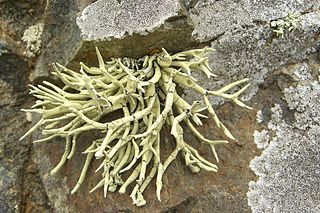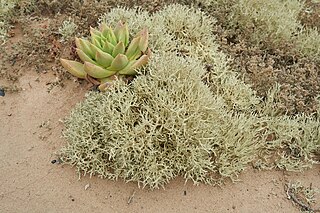Vermilacinia, a genus of lichenized fungi in the family Ramalinaceae, is a yellow-green fruticose type of lichen with about 30 species that grow on rocks, trees, and soil within the fog zone along the Pacific Coast of North America and South America. The genus name refers to the thallus being divided into narrow worm-like (vermis) branches (lacinia);the latter part of the name (lacinia) generally applied in descriptions and taxonomic keys such as exemplified in a key to Sonoran Desert species of Ramalina.

Niebla homalea is a species of fruticose lichen that grows on rocks in foggy areas along the Pacific Coast of North America, from Mendocino County, California south to Bahía de San Quintín on the main peninsula of Baja California, with an isolated occurrence further south on vertical rock faces above Punta Camachos, and other occurrences in the Channel Islands and on Guadalupe Island. The epithet homalea, given by Acharius, suggests it was in regard to the branches appearing flattened.
Vermilacinia cedrosensis is a species of pale fruticose lichen that is endemic to Baja California, Mexico.
Vermilacinia combeoides is a fruticose lichen found on rocks along the Pacific Coast of North America from Sonoma County, California south to San Quintín, Baja California, and also on Santa Catalina Island and Guadalupe Island.
Vermilacinia laevigata is a fruticose lichen that occurs in the fog zone along the Pacific Coast of the California Floristic Province from Marin County, California to 15 miles south of Misión San Vicente Ferrer in Baja California
Vermilacinia paleoderma is a pale yellow-green fruticose lichen that occurs commonly along the fog zone of the Pacific Coast of Northern Vizcaíno Desert region of Baja Californica and occasionally in the Chaparral Islands of California.

Vermilacinia procera is a fruticose lichen of local occurrences on rocks near the sea along the Pacific Coast from San Francisco California to the Channel Islands, and to Punta Escarpada in Baja California. The species is also reported to occur further south to the Vizcaíno Peninsula and on Cedros Island, but these reports are controversial in view of different interpretations of the species that include V. pumila and V. paleoderma that were not recognized at the time V. procera was described ; for example, a specimen collected on Guadalupe Island by Weber and MCoy (L-3605, COLO that was cited by Phillip Rundel and Peter Bowler in 1994 as belonging to Niebla procera, whereas in a revision of the genus by Richard Spjut in 1996, it was cited as belonging to Vermilacinia paleoderma. Both authorities generally agree to some extent on the description of the species and its geographical range within the California Floristic Province.
Vermilacinia cephalota is a fruticose lichen usually found on trees, shrubs and wooden fences in the fog regions along the Pacific Coast of North America from southeastern Alaska to the Vizcaíno Peninsula of Baja California.
Vermilacinia leonis is a fruticose lichen usually found on branches of shrubs in the fog regions along the Pacific Coast of North America and South America; in North America it is found on the southern half of the main peninsula of Baja California north to the southern coast of the Vizcaíno Peninsula. In South America, it occurs on bushes and rocks in Chile; reported from Colchaqua (Valley) and Santiago The epithet is in regard to absence of the black transverse bands often seen in other species such as V. leopardina, V. tigrina and V. zebrina.
Vermilacinia leopardina is a fruticose lichen usually that grows abundantly on the branches of shrubs in the fog regions along the Pacific Coast of North America, in the Channel Islands and on the mainland of California from Santa Barbara County south to the Vizcaíno Peninsula of Baja California. The species is also reported to occur in Chile, based on a single specimen mounted on a large index card off to one corner with the type (biology) of Usnea tumidula in the center and bottom ; it is possible that the specimen of V. leopardina was from North America and placed on the card for the purpose of making a comparison to the type for Usnea tumidula, which was annotated Ramalina ceruchis var. gracilior Muell.Arg., a name of uncertain status. The epithet, leopardina, is in reference to the black transverse bands and irregularly shaped black spots commonly seen on the thallus branches that obviously imply a similarity to the leopard animal, while also making comparative distinctions to other black banded species: V. tigrina and V. zebrina, obviously to a tiger and zebra, and to V. leonis, obviously a lion, which has no black stripes.
Vermilacinia tigrina is a fruticose lichen that grows on branches of shrubs and on earth among cactus and shrubs in the fog regions along the Pacific Coast of North America and South America; in North America found in the Channel Islands and near San Diego, California, and in central and southern Baja California; and in South America from Peru to Chile. The epithet is in reference to the irregular black spots or bands on the thallus branches.

Niebla arenaria is a fruticose lichen that grows along the Pacific Coast of North America in the fog regions of the northern peninsula of Baja California from near Colonet south to Morro Santo Domingo. The epithet, arenaria, is in regard to the species growing on sand.
Niebla homaleoides is a fruticose lichen that grows on rocks within a narrow region of the foggy Pacific Coast of Baja California in the Northern Vizcaíno Desert, Arroyo Sauces, Punta Cono and ridges south of Punta Negra. The epithet, homaleoides is in reference to the similarity to Niebla homalea.
Niebla infundibula is a fruticose lichen that grows on rocks along the Pacific Coast in the Channel Islands of California and in Baja California on Guadalupe Island, and on the main peninsula in the southern region of the Northern Vizcaíno Desert on a ridge south of Punta Negra. The epithet, infundibula, is in reference to the funnel shape of the thallus branches.
Niebla josecuervoi is a fruticose lichen that grows on rock, stony soil and sand along the Pacific Coast of northern Baja California from near Misión San Vicente Ferrer to Punta Santa Rosalilillita. The epithet, josecuervoi is in honor of a field assistant, “Jose Cuervo”.
Niebla limicola is a fruticose lichen that grows on barren mud flats and on sand among salt scrub along the Pacific Coast of the Vizcaíno Desert, of Baja California from San Vicente Canyon to Scammon’s Lagoon. The epithet, limicola is in reference to the thallus growing on barren (alkali) soil.
Niebla pulchribarbara is a rare fruticose lichen that occurs on sandy beaches or gravelly soil along the Pacific Coast, at San Antonio del Mar and at Bahía de San Quintín, Baja California. The species epithet, pulchribarbara, is in reference to the strikingly beautiful lichen mat formed by the thallus.
Niebla spatulata is a fruticose lichen that grows on small rocks along the foggy Pacific Coast of central Baja California in the Vizcaíno Desert. The epithet, spatulata is in reference to the flattened branches of the thallus, in contrast to another similar species, Niebla flabellata.
Niebla testudinaria is a fruticose lichen that grows on rocks along the foggy Pacific Coast of North America, from Marin County, California to just south of Tijuana in Baja California, in the Channel Islands in California, and Isla San Martín and Guadalupe Island in Baja California The epithet, testudinaria given by William Nylander in 1870, is probably in reference to the dilated branch with a reticulated surface, similar to a tortoise shell.
Niebla undulata is a fruticose lichen that grows on rocks in the fog zone along the Pacific Coast of Baja California in the Northern Vizcaíno Desert, and also in the Channel Islands. The epithet, undulata, is in reference to the wavy margins of the thallus.



